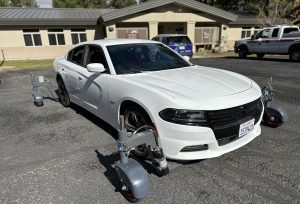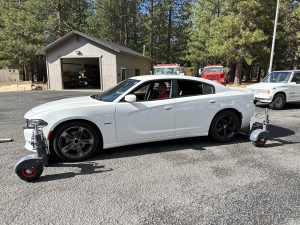College of the Siskiyous Law Enforcement Academy
 They’re swerving, sliding and spinning out… but it’s all good. In fact, it’s by design.
They’re swerving, sliding and spinning out… but it’s all good. In fact, it’s by design.
Students in the Law Enforcement Academy at College of the Siskiyous are taking control of their careers by losing control of their cars. Thanks to recent Strong Workforce funding, the College is receiving full support to upgrade its dynamic SKID CAR training facilities. The specialized instruction helps cadets learn how to recognize when oversteering or understeering is occurring, and how to respond to maintain control of the vehicle as it loses traction.
This training is a vital lesson for cadets who, as first responders, will often find themselves in situations out in the field where they may lose control while moving at high speeds — especially on rough roads or during the months of inclement weather the region is known for.
“In law enforcement, as in other public safety fields, we’re required to routinely drive in circumstances well beyond what most people will normally safely drive,” says Louis Mero, Director of the Law Enforcement Academy at College of the Siskiyous.
“We’re expected to be able to get to anywhere that people need that help … Learning how the vehicle works, how it really moves, understanding the limits of traction control, it’s these kinds of experiences and critical training that gives us the necessary tools and understanding to be able to get safely where we need to be in order to help those who need it most.”
The SKID CAR’s specialized framework attaches to the vehicle as a controller carefully lifts or lowers both the front and rear tires of the vehicle. This gives the driver the experience of losing traction without having to practice on water or a special surface – and at a much lower and safer speed.
“After the student is given proper direction, the instructor drives around the course very slowly without activating any of the hydraulics of the car to get the students acquainted with how the car reacts,” explains Rick Alves, SKID CAR instructor in the Administration of Justice department at the College of the Siskiyous.
“Then, the instructor will go around and activate the hydraulics … transferring the weight of the car, simulating a high-speed turn. I personally like to spin out to show the student that even if they lose control, it’s not any big deal.”
With the special hydraulic framework, it’s simple for a student to safely make a mistake, learn the necessary corrective skill, and continue with their lesson.
“We’re doing 15 to 20 miles an hour in a controlled area,” continues Alves. “So, if a student does spin out, at worst they may knock over a few cones … we get out, put them back up and start fresh again.”
The SKID CAR training has been provided at the College of the Siskiyous for almost seven years. Prior to the mechanics and framework on a physical vehicle, the training was offered via virtual reality, with students sitting in pod-like structures with screens to immerse the driver in a real-life scenario. Mero says students were not responding well to the VR training, and he realized it was time to provide cadets with a more realistic, hands-on experience.
“Their absorption of knowledge and demonstration of skill is a thousand percent more effective than it was before,” reflects Mero. “Students and instructors are excited about this training. They want to drive next; they don’t want to switch out and they can’t wait to do it again.”
From the screech of tires on pavement, to the roar of the engine as students lower the gas pedal — Mero notes that feeling and understanding the practical capabilities of the car is proving more powerful than a simple computer screen.
“This is why we like the SKID CAR. It allows us to create proficiency at a higher rate because we can replicate the circumstances of the physical dynamic forces that affect control of the vehicle.” 
Thanks to Strong Workforce funding, the program is getting another well-deserved upgrade. Instead of being limited to the designated parking lot to practice the techniques, instructors are taking these specialized vehicles mobile. With the new upgrades to the vehicle’s framework, the SKID CAR equipment can be easily folded to fit into a trailer and brought to almost any location.
This new framework isn’t reserved just for the Academy’s cadets. Plans are in motion to expand training across the community. The goal is to help prepare first responders, truck drivers, high school student drivers, and members of the surrounding counties develop skills for safer driving.
The Law Enforcement Academy at College of the Siskiyous is hoping to connect with local transportation departments, buses, school vans, or any city agency with a fleet of vehicles to host these trainings with the mobile SKID CAR framework.
“We want to take something that’s offered to us through Strong Workforce funds and be able to expand it beyond just this original concept, to something much more broad, something for the community,” explains Mero.
“What we’re trying to do is give the driver confidence in their driving and show them that the vehicle is going to act the same at various speeds, it’s just the distances you’re traveling will increase with your speed increasing,” adds Alves. “So, if you go into a skid at 25 miles an hour or if you go in at 50 miles an hour, the vehicle is going to act basically the same.”
The mobile SKID CAR unit is giving smaller law enforcement agencies a chance to experience and learn on the equipment. The Academy aims to host these agencies through regional trainings throughout the 13 surrounding counties the College of the Siskiyous services.
“The more Far North go you, it’s less populated, and therefore less [of] a substantial financial base,” says Mero. “This gives every officer, every deputy in our area, the chance to have access to high quality trainings with skill builder exercises at a reasonable cost.”
In addition to the new SKID CAR training capabilities, Strong Workforce funding is unlocking a new realm of possibilities for students in the College of the Siskiyous’ Law Enforcement Academy. The funding is assisting cadets in covering costs for the safety equipment required for the program. These law enforcement essentials can end up costing a student $1,500 to $2,000 out-of-pocket. With help from the Strong Workforce Program, students don’t need to stress — the costs to use these safety materials are completely covered.
“We bought complete duty gear, we bought all of the firearm packages, we have all the safety equipment, so students coming into our Academy don’t have to outlay this cash not knowing what could be in their future,” says Mero.
Meanwhile, Strong Workforce funding is bolstering the Law Enforcement Academy’s fleet by purchasing sleek, new vehicles ready for training and cadet use.
Through these turbocharged vehicles, covered equipment costs, and the new SKIDCAR capabilities, cadets in COS’s Law Enforcement Academy are getting authentic instruction for a high-impact career. The Academy is continuing to provide top tier training for the future cadets in the region, along with the surrounding community.
“Having investment dollars like Strong Workforce dollars to be able to purchase unique equipment that directly translates to student learning in a more rural area, like the Far North, is pretty special for us,” proudly states Mero.
“Those things would not be able to happen without outside support.”
October 2023